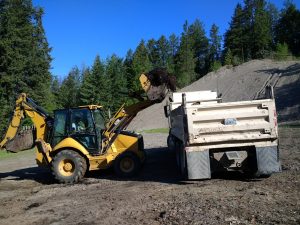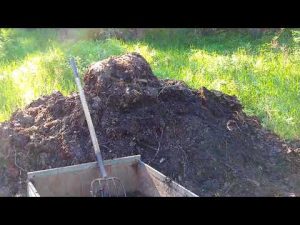“A biome is a specific environment that’s home to living things suited for that place and climate.” (Vocabulary.com)
Maybe I am still trying to apply my degree in philosophy, or just spend too much time alone in the vineyard, but there is a lot to think about in developing Regenerative Agriculture in a specific place. This last month the vineyard has dried out. The record-breaking rains of March and April were followed by record-breaking heat in May. That gave me a chance to have two 14 yard dump trucks full of leaf compost (actually more leaf than compost) from a fall yard-waste dump for the city of Colville brought in to my soil yard when the dump dried out enough for trucks. I am mixing it with cow manure, biochar and shredded branches and spreading it between the rows in the vineyard. This variety of carbon and living organisms is meant to build the soil and the soil in turn works with the grapes, grasses, clover and other cover crops in the vineyard to build a biome. (This term usually has a broader meaning such as Forest or Tundra.)
The main idea here is that a complete mixture of living organisms in all stages of their life cycles provides better nutrition for the grapes, better resilience against flood, drought, hot, cold, insects – whatever the climate throws at it – than any mixture of chemical fertilizer, tilling or decaying matter. I have already begun putting spent yeast from wine making back in the vineyard and will be adding shredded pruned canes as well as seeds and skins left from primary fermentation back as well. The cover crop will rebound from mowing and the symbiotic exchange of sugars from plant roots for water and minerals through mycorrhizal fungi will strengthen plant vitality. Fungi are already boosting my cutting reproduction from 50% to nearly 100%. There are lots of worms in the compost and bacteria creating nutrients as well. I’m trying to blend these ingredients to build a biome.
I expect that repeating application of these biome builders over several years will increase the fertility of the vineyard and therefore production. There are some arguments for stressing vines to improve sugar and the quality of the wine. My thinking is more like “Happy vines make happy wines.” We’ll have to see how this plays out.
One of the many books I read on regenerative agriculture this last winter noted that nature seems to be self-correcting. An organism that degrades the ecology and reduces bio diversity fouls its own nest and inevitably learns to limit its growth or dies out entirely by destroying its environment. An example might be leafhoppers. There were a lot of them in some parts of the vineyard this spring and I did spray some organic pesticide on them. But with a few good rain storms they have subsided markedly. New growth is sprouting up next to the leaves that they damaged. In the Fall, the inner leaves that they tend to weaken fade away and allow the sun to ripen the grapes sooner. As long as the plants grow rapidly, natural predators such as wasps, spiders and ladybugs will keep the leafhoppers in check.
I’m not sure I can paint an equally rosy picture for mites or powdery mildew. There is a lot of observation and learning left to do. The implicated principle however is that diversity builds resilience and that can be applied to people as well as plants and insects. History shows that immigrants tend to be hard-working adaptive people.




I assume you have read about the predatory mites. UC Davis has done a lot of research on them.
I assume you probably know the following, but I thought I would mention it. creating a mildly acid environment tents to inhibit fungi.
Old Farmer’s Almanac on powdery mildew: Spray infected plants with fungicides. Effective fungicides for powdery mildew treatments or cures include sulfur, lime-sulfur, neem oil, and potassium bicarbonate. Spray your plants with fungicides according to their directions. If you don’t want to use fungicides, try spraying your plants with a solution of 1 teaspoon baking soda in 1 quart of water. Remember to spray your plants thoroughly.
PermalinkThanks Klugy. Actually I seldom have a problem with either of these. I do have a folder of mildew solutions. Mites seem to be a dormant spray issue but are not a significant problem right now.
Permalink